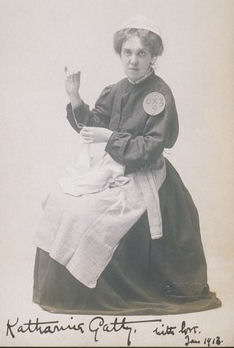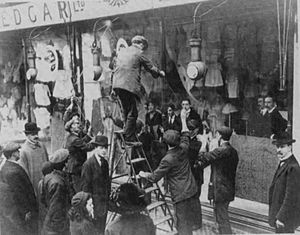Katharine Gatty facts for kids
Katharine Gatty (born June 11, 1870 – died May 1, 1952) was a nurse, writer, speaker, and a strong supporter of women's rights. She was a key member of the Women's Social and Political Union (WSPU). This group fought for women to get the right to vote. Katharine was given a special Hunger Strike Medal because she went on a hunger strike in prison. During this time, she was even force-fed. Later in her life, she lived in the United States before moving to Australia, where she spent her final years.
Contents
Katharine Gatty's Early Life
Emma Katharine Gatty was born in 1870 in Ferozopur, Bengal, India. Her mother, Emma Rebecca, was from Ireland. Her father, Captain Edward Gatty, was a soldier. By 1881, after her father passed away, Katharine and her mother lived in Hammersmith, London.
Katharine started her journey as an activist at just 18 years old. She took part in the Great Dock Strike of 1889. This was a big event where workers fought for better pay and conditions. In 1908, Katharine was chosen to represent her group at an important meeting in Amsterdam. This meeting was about women's issues around the world.
Fighting for Women's Rights
Katharine Gatty joined the Women's Social and Political Union (WSPU) and became a very active suffragette. Suffragettes were women who used protests and sometimes civil disobedience to gain the right to vote. Katharine once chained herself to the gates of Hyde Park as a protest. The suffragette newspaper Votes For Women described her as a journalist and a speaker.
Imprisonment and Hunger Strikes
Katharine was first sent to Holloway Prison in 1909 for one month. In 1911, she worked for the Women's Tax Resistance League in London. This group believed women should not pay taxes if they couldn't vote.
In November 1911, Katharine was arrested again. She had taken part in a protest where women broke windows. This happened after the government stopped a bill that would have helped women get the vote. She was sentenced to three weeks in Holloway Prison. While there, she went on a hunger strike. This meant she refused to eat. For her bravery, the WSPU gave her a Hunger Strike Medal.
In March 1912, Katharine joined another window-smashing protest for the WSPU. She was sentenced to six months in prison. At her trial, she argued that property damage was treated more seriously than harm to people. She pointed out that men who hurt women often received lighter sentences.
While in prison in April 1912, Katharine went on another hunger strike. The prison doctors tried to force-feed her, which means they made her eat against her will. She went on hunger strike again in June of that year and was force-fed 13 times.
Continued Activism
After being released from prison in August 1911, Katharine was immediately arrested again. She had broken a window at a post office in Abergavenny, Wales. She said she did this to protest that women were not allowed to vote. For this, she received one month of hard labor in prison, which affected her health.
Later in 1912, Katharine became the Secretary for the Suffrage Atelier (SA). This was a group of artists who created postcards, posters, and banners to support the women's right to vote movement.
Katharine was a close friend of Emily Davison, another suffragette. Emily Davison was tragically killed in 1913 when she ran in front of a horse at the Epsom Derby.
Katharine was imprisoned nine times for her work for women's right to vote. She also fought to end the death penalty. She was an active member of groups that helped people in need around the world. She also helped organize the Co-operative Party in England. Katharine always supported Irish Home Rule, which was about Ireland governing itself.
In the early 1920s, Katharine trained to be a nurse and qualified in 1924. She continued to be a registered nurse until at least 1934.
Later Years and Legacy
In September 1934, Katharine Gatty attended a conference about global justice. In the mid-1930s, she lived in Greece for a while. In 1937, Katharine moved to California in the United States. She lived there through the 1940s. In 1938, she gave a speech at Stanford University about governments that take away people's freedoms. She shared her own experiences from Italy.
Emma Katharine Gillett-Gatty moved to Strathfield, Australia, in 1947. She passed away there in 1952 at the age of 81. In her will, she made a special request. She wanted her eyes to be donated to two blind people. She also asked to be cremated or buried at sea.
Her letters from prison are kept in the Archive of the Women's Library at the London School of Economics. They tell the story of her brave fight for justice.



